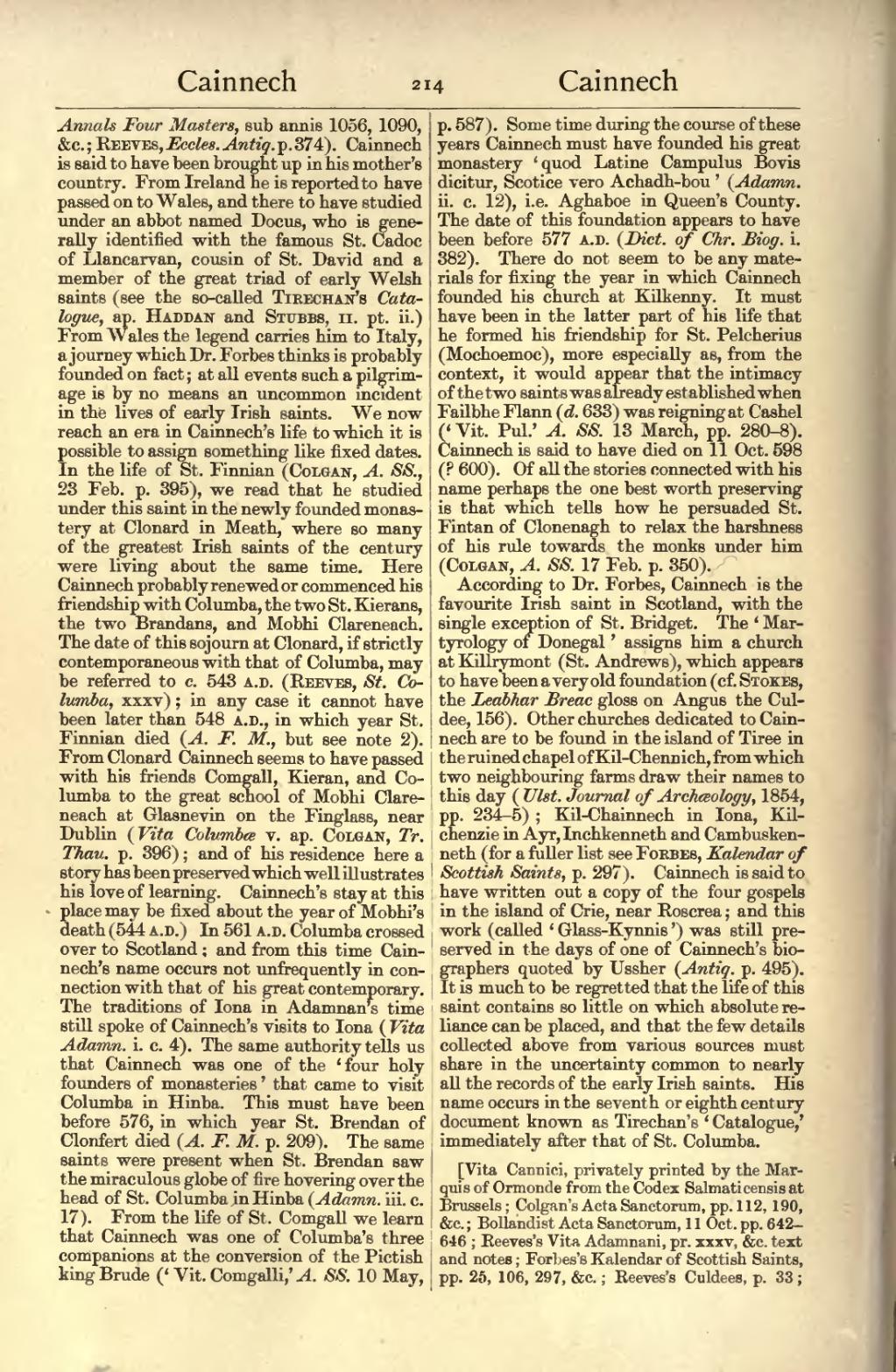Annals Four Masters, sub annis 1056, 1090, &c.; Reeves, Eccles. Antiq. p. 374). Cainnech is said to have been brought up in his mother's country. From Ireland he is reported to have passed on to Wales, and there to have studied under an abbot named Docus, who is generally identified with the famous St. Cadoc of Llancarvan, cousin of St. David and a member of the great triad of early Welsh saints (see the so-called Tirechan's Catalogue, ap. Haddan and Stubbs, ii. pt. ii.) From Wales the legend carries him to Italy, a journey which Dr. Forbes thinks is probably founded on fact; at all events such a pilgrimage is by no means an uncommon incident in the lives of early Irish saints. We now reach an era in Cainnech's life to which it is possible to assign something like fixed dates. In the life of St. Finnian (Colgan, A. SS., 23 Feb. p. 395), we read that he studied under this saint in the newly founded monastery at Clonard in Meath, where so many of the greatest Irish saints of the century were living about the same time. Here Cainnech probably renewed or commenced his friendship with Columba, the two St. Kierans, the two Brandans, and Mobhi Clareneach. The date of this sojourn at Clonard, if strictly contemporaneous with that of Columba, may be referred to c. 543 A.D. (Reeves, St. Columba, xxxv); in any case it cannot have been later than 548 A.D., in which year St. Finnian died (A. F. M., but see note 2). From Clonard Cainnech seems to have passed with his friends Comgall, Kieran, and Columba to the great school of Mobhi Clareneach at Glasnevin on the Finglass, near Dublin (Vita Columbæ v. ap. Colgan, Tr. Thau. p. 396); and of his residence here a story has been preserved which well illustrates his love of learning. Cainnech's stay at this place may be fixed about the year of Mobhi's death (544 A.D.) In 561 A.D. Columba crossed over to Scotland; and from this time Cainnech's name occurs not unfrequently in connection with that of his great contemporary. The traditions of Iona in Adamnan's time still spoke of Cainnech's visits to Iona (Vita Adamn. i. c. 4). The same authority tells us that Cainnech was one of the ‘four holy founders of monasteries’ that came to visit Columba in Hinba. This must have been before 576, in which year St. Brendan of Clonfert died (A. F. M. p. 209). The same saints were present when St. Brendan saw the miraculous globe of fire hovering over the head of St. Columba in Hinba (Adamn. iii. c. 17). From the life of St. Comgall we learn that Cainnech was one of Columba's three companions at the conversion of the Pictish king Brude (‘Vit. Comgalli,’ A. SS. 10 May, p. 587). Some time during the course of these years Cainnech must have founded his great monastery ‘quod Latine Campulus Bovis dicitur, Scotice vero Achadh-bou’ (Adamn. ii. c. 12), i.e. Aghaboe in Queen's County. The date of this foundation appears to have been before 577 A.D. (Dict. of Chr. Biog. i. 382). There do not seem to be any materials for fixing the year in which Cainnech founded his church at Kilkenny. It must have been in the latter part of his life that he formed his friendship for St. Pelcherius (Mochoemoc), more especially as, from the context, it would appear that the intimacy of the two saints was already established when Failbhe Flann (d. 633) was reigning at Cashel (‘Vit. Pul.’ A. SS. 13 March, pp. 280–8). Cainnech is said to have died on 11 Oct. 598 (? 600). Of all the stories connected with his name perhaps the one best worth preserving is that which tells how he persuaded St. Fintan of Clonenagh to relax the harshness of his rule towards the monks under him (Colgan, A. SS. 17 Feb. p. 350).
According to Dr. Forbes, Cainnech is the favourite Irish saint in Scotland, with the single exception of St. Bridget. The ‘Martyrology of Donegal’ assigns him a church at Killrymont (St. Andrews), which appears to have been a very old foundation (cf. Stokes, the Leabhar Breac gloss on Angus the Culdee, 156). Other churches dedicated to Cainnech are to be found in the island of Tiree in the ruined chapel of Kil-Chennich, from which two neighbouring farms draw their names to this day (Ulst. Journal of Archæology, 1854, pp. 234–5); Kil-Chainnech in Iona, Kilchenzie in Ayr, Inchkenneth and Cambuskenneth (for a fuller list see Forbes, Kalendar of Scottish Saints, p. 297). Cainnech is said to have written out a copy of the four gospels in the island of Crie, near Roscrea; and this work (called ‘Glass-Kynnis’) was still preserved in the days of one of Cainnech's biographers quoted by Ussher (Antiq. p. 495). It is much to be regretted that the life of this saint contains so little on which absolute reliance can be placed, and that the few details collected above from various sources must share in the uncertainty common to nearly all the records of the early Irish saints. His name occurs in the seventh or eighth century document known as Tirechan's ‘Catalogue,’ immediately after that of St. Columba.
[Vita Cannici, privately printed by the Marquis of Ormonde from the Codex Salmaticensis at Brussels; Colgan's Acta Sanctorum, pp. 112, 190, &c.; Bollandist Acta Sanctorum, 11 Oct. pp. 642–646; Reeves's Vita Adamnani, pr. xxxv, &c. text and notes; Forbes's Kalendar of Scottish Saints, pp. 25, 106, 297, &c.; Reeves's Culdees, p. 33;
